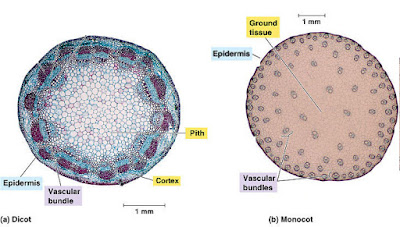April 7 has arrived, and being a tree-follower, I’m posting the latest news of my tree at the monthly gathering kindly hosted by The Squirrelbasket. If you like trees and would like to join us, check out the links above (it’s interesting and fun, with no obligation).
This year I’m following an extinct tree—Sabalites powellii, a palm that grew in southwest Wyoming 50 million years ago. I discovered it in December in our Geology Museum, and in May I will visit its ancient habitat. In the meantime, tree-following consists of learning about Sabalites and its world. This month, I decided to look into its wood. The Green River Formation—the rock layers where fossilized fronds have been found—also contains fossilized palm wood. It’s common, beautiful, and popular with collectors.
 |
|
Fossilized palm wood is the state rock of Texas (source).
|
However, my search for “Sabalites wood” was futile, both in Google and the scientific literature. That’s because fossil palm wood is called Palmoxylon. Is this weird? Are paleobotanists exceptionally obsessed with publishing new names?
 |
|
Sabalites powellii, a fossil palm frond “species” from southwest Wyoming.
|
 |
|
Palmoxylon includes 200+ “species” of fossil palm wood (source).
|
Plant fossil names proliferate because paleobotanists are faced with an unfortunate situation. Most fossilized plants are actually fossilized plant parts—leaves, branches, flowers, etc., that fell off some plant. Generally there’s no way to know if different parts came from the same species, so they’re given different names.
Palm wood usually is easy to recognize. Cutting a petrified palm trunk cross-wise reveals a characteristic pattern of scattered dots—the vascular bundles that conduct water and nutrients up and down trees.
 |
|
Cross-section through petrified Palmoxylon log (click on image to view dots; source).
|
 |
|
Length-wise view of Palmoxylon (source). Xylon means “one having (such) wood—in generic names” (Merriam-Webster) … in this case, having palm wood.
|
In most trees (dicots), vascular bundles are arranged near the perimeter, but in monocots, they're scattered through the stem (diagram below). Monocots include orchids, grasses, lilies and more. Most are herbaceous, but a few produce wood and grow large, e.g. yuccas, bamboos and palms.
 |
|
Cross-sections through dicot and monocot stems (source, modified).
|
Wait a minute!!! As botany students we're taught that monocots don’t make wood. Wood is produced by secondary growth in the vascular cambium (below), and monocots have no vascular cambium. Yet palms are monocots and obviously woody … ??
 |
|
In dicots, wood develops from secondary growth via the vascular cambium (source, modified).
|
Large monocots are said to produce strong trunks through abnormal secondary growth. I think we call it “abnormal” because it’s disorderly and hard to categorize … and poorly understood. Webpage after webpage explains that palms thicken their trunks through diffuse secondary growth, in which parenchyma cells divide and enlarge. And yet a recent study revealed that at least some palms have a vascular-cambium-like meristem! (Botánico & Angyalossy 2013; article here):
“… we analysed palm stems of four species, with the aim to understand the possible presence of such secondary growth. We found that a meristematic band occurs between the cortex and the central cylinder and gives rise to new vascular bundles and parenchyma internally, producing parenchyma and fibres externally. … In fact, a meristematic band is present and may be more common than currently believed, but uneasy to detect in certain palms for being restricted to specific regions of their stems.”
Palms’ tough rigid tissue may not be “true wood,” but it’s called wood and functions as wood. Some kinds are used in construction, including that of the coconut palm. Wood from the outer part of the trunk, where the vascular bundles are dense, is harder even than oak and Douglas fir (source).
In fact, sometimes palm wood is better than true wood. It's more flexible—palms can bend 40º without breaking! The tough fibrous vascular bundles scattered through the trunk serve as plant rebar—like the steel rods that give strength and flexibility to reinforced concrete.
 |
|
Flexibility is a great adaptation in hurricane-prone environments. Courtesy US Navy.
|
 |
|
When a tropical cyclone tore through this rainforest, the palms were left standing (source).
|
We'll stop here. Once again, tree-following has taken me on a winding journey, this time to fossil palm wood, woody monocots, meristems, vascular bundles and finally rebar. We’re lucky there’s so much of interest in this world!



That was absolutely fascinating! I hadn't even realised that palms were dicots (it was never mentioned in Biology A-level)...
ReplyDeleteAnd who knew that states had their own state rocks? That polished gem is beautiful in a very special way.
Thank you for keeping on keeping on and finding something new every time! I guess your May visit will be reported in June, but I have confidence you will entertain and inform us again next month.
All the best :)
Thanks, sb. No ideas now for May ... but somehow they manage to show up.
DeleteDefinitely fascinating, Hollis! I realize I know very little about palm growth; when one begins to enumerate all their unusual characteristics, they seem like something other than trees, yet that is certainly their role.
ReplyDeleteThanks, Amy. After all this reading, I'm really looking forward to seeing a live palm! But probably not until September, in California.
Delete